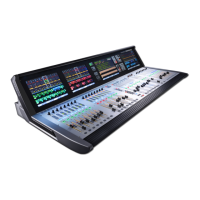4.3: INPUT CHANNEL > DYNAMICS
Vi3000 USER MANUAL
4.3 INPUT CHANNEL > De Esser
Vi3000 USER MANUAL
17.2.2 17.2.2: FX > ALGORITHMS > DELAYS
17.2.2: FX > ALGORITHMS > DELAYS
Tape Delay
Mono In/Stereo Out
In the days before digital, delays were created using a special tape recorder in which the magnetic recording tape was
looped, with closely-spaced recording and playback heads. The delay effect was created by the tape moving in the
space between the record and playback heads – while delay time was adjusted by changing the speed of the tape
loop. Although very musical-sounding, wow and utter combined with a signicant loss of high frequencies, and to
some extent also low frequencies, are all elements commonly associated with tape recordings.
Reverse Delay
Mono In/Stereo Out
This delay effect emulates the old studio trick of ipping a tape over, playing it backwards through a tape delay, and
recording the effect. The delays “build up” from softer to louder – creating the sensation that the delays come before
the signal.
Tempo Range Low Range High
Enter the 'Tempo' Time.
This time is expressed as tempo in BPM (beats per
minute). Tempo works in conjunction with Delay Time to
set the actual delay time that is heard.
Innity 24 BPM
Tap Tempo
Enter the Tempo time by
tapping.
Repeatedly tap the {TAP] button to automatically set the
delay tempo. The console 'F' keys 1-4 are assigned to
the delay tap tempo.
Delay Time
Controls the length of
the delay time relative
to Tempo.
At the middle of its range, delay repeats are synchro-
nous with the Tempo button; lower values create faster
repeats, while higher values increase the time between
repeats.
Dependant
on algorithm
Dependant on
algorithm
Delay Type Range Low Range High
Choose between Tape
and Digital delay types.
2-Tap Delay algorithm only. DIGITAL TAPE
Delay Parameters

